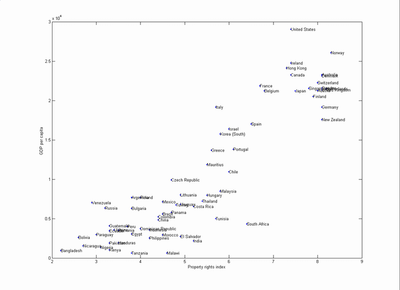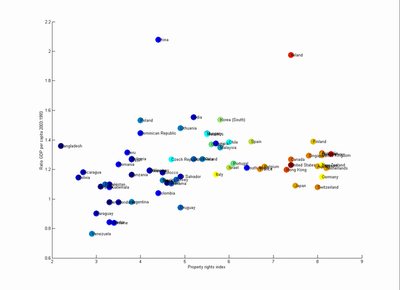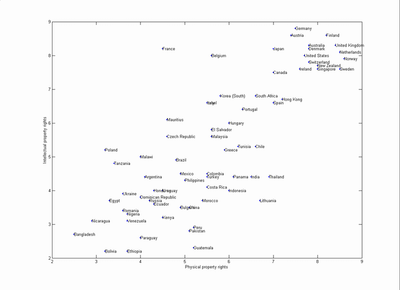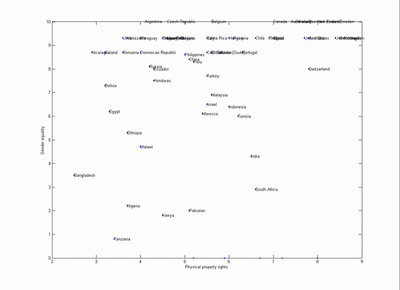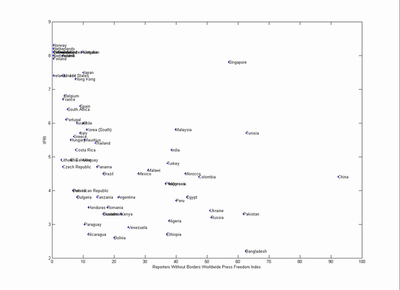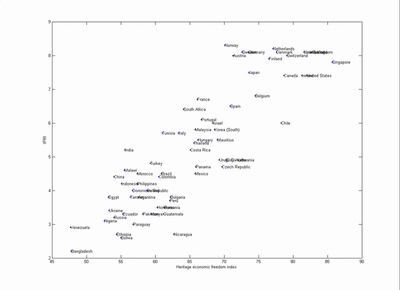March 24, 2007
Selecting for Gay Pagan Babies
 WIRED Bodyhack has a fun blog on Genetically Engineering Your Child's Sexual Orientation. The basic issue is a southern baptist blog by Albert Mohler suggesting that if it was possible to alter a baby's sexual orientation prenatally it would be proper to make it heterosexual. As pointed out by Bodyhack, this is a tricky issue for pro-choice people: would they accept abortions of fetuses based on their orientation?
WIRED Bodyhack has a fun blog on Genetically Engineering Your Child's Sexual Orientation. The basic issue is a southern baptist blog by Albert Mohler suggesting that if it was possible to alter a baby's sexual orientation prenatally it would be proper to make it heterosexual. As pointed out by Bodyhack, this is a tricky issue for pro-choice people: would they accept abortions of fetuses based on their orientation?
Pro-choice and anti-selection attitudes seem to regularly collide, and genetic councelors have a hard time resolving these contradictions. On the other hand, being pro-life and for selection would require being for germline modification or other rather invasive processes in utero, something which goes against the conservative ethos the pro-lifers generally adhere to. Maybe the solution is to adopt away the gay babies.
As a libertarian I'm of course pro-choice and pro-selection.
However, there is an even funnier twist here. Would Albert Mohler support interventions to promote religious babies?
Twin studies show that religiousness has a reasonably strong heritability, about 44%, and that it increases with age (i.e. people develop to their genetic level of religiousness). See also this, this, this and this paper. There is also a negative correlation between serotonin binding and 'self-transcendence', a personality trait covering religious behavior and attitudes. Presumably, by setting the density of serotonin receptors and other correlates of spirituality the adult religiosity of children could be influenced. The heritability looks a bit lower than for sexual preference, so it would still be rather random - or with space for free will, if one wants to interpret it charitably.
Given that Mohler claims that "we should unapologetically support the use of any appropriate means to avoid sexual temptation and the inevitable effects of sin", it seems equally reasonable to support the use of any appropriate means to develop faith and spirituality. And since faith in his system of thought (I think) ought to be a way to reduce sins (or their effects) any means OK to apply for reducing sins ought to be OK to apply to increasing faith.
Of course, the flaw in this is that the particular religion of the child is not set. While the choice of religion tends to be heavily affected by upbringing there is no guarantee that the child will remain within the fold. Self-transcendent people may be fulfilled and humble enough that they do not stray often, but some will no doubt convert to religions their parents find distasteful.
Would the selection rob the child of free will? I don't think so. What is being set is parts of personality traits, not the thoughts or reactions of the emerging person. They will bias and affect the thoughts, but no more and no less than any other personality traits. That these ones were selected does not give the parents more control over the child or predetermine its destiny.
A theological argument against would be that God would make sure to give the right genome, and that parents should trust God to do it right. But if that is true, then God seems to like gays too.
March 22, 2007
The Consolidation of Reconsolidation
 When I began my neuroscience research memory consolidation (both molecular and network) was the hot thing: the chemistry, neuropsychiatry and theories were lining up, all that was lacking was mid-level evidence to demonstrate actual consolidation from the hippocampus to cortex, as well as better neural network models of how it was done. By now it looks like most of this has been achieved (although I still think our neural network models of hippocampus-cortex transfer are a bit weak).
When I began my neuroscience research memory consolidation (both molecular and network) was the hot thing: the chemistry, neuropsychiatry and theories were lining up, all that was lacking was mid-level evidence to demonstrate actual consolidation from the hippocampus to cortex, as well as better neural network models of how it was done. By now it looks like most of this has been achieved (although I still think our neural network models of hippocampus-cortex transfer are a bit weak).
Fortunately we got reconsolidation to complicate matters. This phenomen has rapidly gone from a fringe claim to the new hottest topic. See "Rites of Passage of the Engram: Review Reconsolidation and the Lingering Consolidation Hypothesis" by Yadin Dudai and Mark Eisenberg for a review of current models.
That memories can become fluid again poses many interesting issues for how overall memory plasticity works. The original impetus for the network consolidation models was to deal with the problem of overwriting information: we needed a slow learning cortex for long storage and a fast learning hippocampus to portion out the information. But reconsolidation, together with modulation of plasticity from subcortical sources makes the cortex a far more dynamical place. How does these processes produce a fairly stable engram, without accidentally overwriting it? Beats me. But there seem to be some complexity in when reconsolidation can occur, and maybe different kinds of memory and memory ages affect the process. That would imply a much closer link between the network behavior of entire memories and the molecular behavior of how synapses change. Previously the assumption was (at least in my mind) that there was an abstraction level between them, but maybe the brain is messier than we expected.
There are also possible applications such as the one I mentioned on this week's CNE blog, selective memory erasure. Together with consolidation enhancers and drugs that affect consolidation byt not reconsolidation or vice versa suggests a lot of interesting potential for memory editing. And that will of course keep neuroethicists and psychologists busy for a long time.
March 16, 2007
The Door of Deception
 Our office building has a front door that is a fantastic example of bad design. It is so bad that we have a course in the building on how to use it.
Our office building has a front door that is a fantastic example of bad design. It is so bad that we have a course in the building on how to use it.
The door itself is fairly heavy, so an automated opener was added. But this makes it dangerous, so a motion sensor was also added to prevent it from opening and squashing somebody standing too close. After swiping your card you need to step back or squeeze to the side, otherwise the door will not open (with no sign of what is wrong). Visitors who get the door opened by the intercom will be standing in the no-opening zone and have to be told to move away.
 On the inside a button for triggering the opening was added. Note the signs proclaiming that it is an automatic door, yet also pointing out that the button has to be pressed. Most people tend to think that automatic doors opens automatically, but in this case they are wrong. The signs also make it clear that one should not stand too close; too bad that the door opens outwards. On the outside there is a much smaller warning against standing too close.
On the inside a button for triggering the opening was added. Note the signs proclaiming that it is an automatic door, yet also pointing out that the button has to be pressed. Most people tend to think that automatic doors opens automatically, but in this case they are wrong. The signs also make it clear that one should not stand too close; too bad that the door opens outwards. On the outside there is a much smaller warning against standing too close.
 The button was apparently added too high for the reach of wheelchair bound visitors, so another opening button also exists at a convenient height. This green button is also side by side with a green box with the button for emergency opening: when triggered the door opens and remains open until reset by the building manager. Having two green buttons next to each other is of course an invitation to slip, which happens occasionally. There ought to be a plastic 'Molly-guard' on the emergency button to signify that one really has to mean it when pushing, but it is lacking.
The button was apparently added too high for the reach of wheelchair bound visitors, so another opening button also exists at a convenient height. This green button is also side by side with a green box with the button for emergency opening: when triggered the door opens and remains open until reset by the building manager. Having two green buttons next to each other is of course an invitation to slip, which happens occasionally. There ought to be a plastic 'Molly-guard' on the emergency button to signify that one really has to mean it when pushing, but it is lacking.
Once the door is open there is fairly deep access into the building straight from the street, which just happens to be a bit of Oxford's "the wrong side of the track" (complete with a methadone clinic, probation office, homeless shelter, modern art museum and the salvation army).
 Of course, deep access is only possible if one can climb stairs. The entrance leads directly to a flight of stairs that are impassable for anybody in wheelchair. At the stairs there is a bell to call for assistance that maybe connects to someone somewhere. The assistance would mostly consist of telling the visitor to use the back entrance, which is very handicap-friendly and equipped with a hi-tech elevator that talks. No sign about this among the warning signs on the door.
Of course, deep access is only possible if one can climb stairs. The entrance leads directly to a flight of stairs that are impassable for anybody in wheelchair. At the stairs there is a bell to call for assistance that maybe connects to someone somewhere. The assistance would mostly consist of telling the visitor to use the back entrance, which is very handicap-friendly and equipped with a hi-tech elevator that talks. No sign about this among the warning signs on the door.
Our hypothetical wheelchaired person would have had to struggle to get in anyway. Beside the steps outside the door, the motion detector would not have allowed the door to open if there was a wheelchair in front of it - and moving back would likely mean descending the steps, and then having to ascend them and get in through the door before it closes.
 Previously the door had to be unlocked after hours by a passcard and a key. Both had to be used within a few seconds of each other, requiring preparation or a very deft hand (doing it while carrying something else was extremely hard). When that system failed it was replaced with a card and keypad, with individual codes generated centrally and then haphazardly told to the people in the building. The back entrance which merely requires swiping the card at three different readers (and a slow trip up one or two floors in the hi-tech elevator) is much more popular after-hours.
Previously the door had to be unlocked after hours by a passcard and a key. Both had to be used within a few seconds of each other, requiring preparation or a very deft hand (doing it while carrying something else was extremely hard). When that system failed it was replaced with a card and keypad, with individual codes generated centrally and then haphazardly told to the people in the building. The back entrance which merely requires swiping the card at three different readers (and a slow trip up one or two floors in the hi-tech elevator) is much more popular after-hours.
Why is this door so amazingly badly designed? According to people who have been around, it has never worked properly. But the building houses several disparate university departments that normally have nothing to do with each other. The door is not the responsibility of anybody in the building, it is just a problem for everybody. Pooling resources for adding a secretary at the entrance is unlikely in the extreme. So instead whenever a problem is discovered outside agencies are invoked to fix it. And they have indeed fixed every problem - if only to produce new problems.
I'm pretty sure this can be turned into a parable about the nanny state or something, but most of all it is a demonstration of just how badly designed everyday objects can be - and that we put up with it. After all, it is not my job to fix the door, I just work here.
March 15, 2007
Iran as Organ Broker
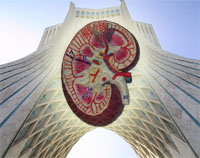 This week at CNE I wrote about organ sales, that perennial theme among us biolibertarians. This time I was inspired by coincidentally reading at the same time about a man who wanted to sell his kidneys to go to the cricket world cup, and a BMJ feature on Iranian organ donation.
This week at CNE I wrote about organ sales, that perennial theme among us biolibertarians. This time I was inspired by coincidentally reading at the same time about a man who wanted to sell his kidneys to go to the cricket world cup, and a BMJ feature on Iranian organ donation.
The Iranian system is definitely not a free organ market; it is state-controlled and heavily regulated. But at least there is compensation to the donors and the possibility of recipients contributing to it. It is getting there.
Since the rules demand that donor and recipient are of the same nationality it will not open Iran for the accusation that rich westerners go there to buy organs from the local poor (unless of course there is some corruption - Iran is doing pretty badly even by mid east standards). But it seems to be a potential opening for Iran to act as an organ broker for foreigners willing to sell their kidneys to compatriots via Iran. It would probably take a more established stream of medical tourists to make it possible, including the crucial realization that there is profit (and altruistic benefit) in opening up the system. On the other hand, "ethical medical tourists" may well demand more transparency of the system.
March 14, 2007
A Chicken in Every Pot and a Website in Every Bottle
 My prediction is coming true! The Pondering Primate: Physical World Connection Helps Combat Counterfeiting describes a system from Aegate for marking individual pharmaceutical bottles so that cellphone cameras can read them and check their website for authenticity. It is not too unlike the Semapedia.
My prediction is coming true! The Pondering Primate: Physical World Connection Helps Combat Counterfeiting describes a system from Aegate for marking individual pharmaceutical bottles so that cellphone cameras can read them and check their website for authenticity. It is not too unlike the Semapedia.
I predicted soda cans with individual websites as standard in 2034 in a roleplaying campaign. It is nice to see that we are getting to the future faster.
Of course, my idea was to actually have a little chip transponder in the can rather than store the can's website on the company server. We already have matchhead webservers, RFID chips and I'm pretty optimistic about low-power plastic electronics in packaging. So the main question will be whether the utility of having a local device that could measure heating and handling, run animated decorations and function independently of the Net is greater than the ease of scanning with a phone and the minor cost of the device.
The biggest irony is that when looking for a picture for this post, I discovered that CCC is actually putting phones and GPS into some cans. We are all living in hyperreality these days.
March 12, 2007
Properties of Property Rights
Recently the first International Property Rights Index comparative study arrived. It is an index that measures how well physical and intellectual property rights are protected in different countries, something which ought to be very important for getting people out of poverty, as shown by Hernando de Soto's work. Since I'm fond of plotting indices, here are a few graphs.
There is a clear link between GDP per capita and the IPRI: property rights are well protected in well-off countries. Italy is an interesting outlier as a rich country with an inefficient bureaucracy, while South Africa seems to be much poorer than it ought to be (perhaps due to the loss of human capital due to AIDS). Cause and effect is of course harder to see, but if we look at the GDP growth from 1993 to 2003 and assume that current property rights also reflect property rights of the last decade, we get the following diagram:
(color denotes 2003 GDP per capita)
The basic message seems to be: low protection of property rights keeps a country poor. Score one for de Soto. The effect appears to be most pronounced for IPRI < 4. In the mid- and upper range other factors are clearly important (as evidenced by the outliers China and Ireland) and the somewhat slower growth for the richest economies.
The real test would be prediction: we should expect growth rates to decline if the index decline (unless special factors like oil windfalls occur) and pick up if the index rises. Bangladesh, Nicaragua and Bolivia might be good tests; unless they protect property rights more their growth will likely plummet.
Subindices
The main index is calculated from four subindices, representing the legal and political environment, physical property rights, intellectual property rights and gender equality. These in turn are calculated from other sources. The subindices are pretty well correlated with the exception of gender equality; the correlations are in the range 0.77-0.89.
Overall the countries cluster nicely, with France as a bit of an outlier with weaker physical property rights but very strong intellectual property righs (it is brought down by the hopeless system for registering property and the lack of easy loans, key factors in de Soto's theory).
The gender equality subscale correlates rather badly with the other scales, so on the positive side it contributes new information, but it might also be adding noise. Most developed countried end up with a high degree of equality, with exceptions like Switzerland and South Africa.
Other Indices
How does the IPRI compare to other indices of freedom and civil society? Note that some of the subindices are calculated from other indices, so there is a risk of automatic correlation.
The Reporters Without Borders Worldwide Press Freedom Index produces an interesting curvilinear relationship (here low scores represent more press freedom).
Countries with less press freedom have in general less secure property rights. Even a small decrease in press freedom corresponds to a major decline in the security of property. However, there seem to be a turn around 30 as the less press free states are all over the map. It is pretty noticeable that these are the poorer per capita countries (with the exception of Disneyland-with-death-penalty Singapore). Maybe the zone around press freedom 20-30 represents an unstable state: enough press freedom to enable citizens to cause significant change if they also have safe property, forcing further press freedom.
The correlation with the Freedom House index was about 0.6, largely because of the same curving relationship (the two indices correlate to 0.86).
On the other hand, with the Heritage index of economic freedom has a solid 0.87 correlation with the property index. This is unsurprising, since it even includes a property rights subindex that correlates to 0.92 with the IPRI.
Summa summarum, IPRI is pretty correlated with other indices for how free societies are in a political and economical sense. Press freedom appear to be the a somewhat different kind. The equality subindex also seems pretty weakly correlated with most of the other indices, with the exception of a modest 0.51 correlation with the Freedom index.
Converging Cognitive Enhancements
 Nick and I have another paper out: Converging Cognitive Enhancements, Ann. N.Y. Acad. Sci. 1093: 201–227 (2006). It is part of a NY annals volume titled Progress in Convergence: Technologies for Human Wellbeing edited by William Sims Bainbridge and Mihail C. Roco.
Nick and I have another paper out: Converging Cognitive Enhancements, Ann. N.Y. Acad. Sci. 1093: 201–227 (2006). It is part of a NY annals volume titled Progress in Convergence: Technologies for Human Wellbeing edited by William Sims Bainbridge and Mihail C. Roco.
Beside "NBIC" we talk about collective enhancement and how cognitive enhancement is ideal for convergence. We also sketched (mostly as an example) of how we might combine pharmacological memory enhancement, TMS, wearables and training techniques with a bit of nanotechnology for improved control over cortical plasticity. Another idea is "wikiepidemology", the potential for collaborative informal large epidemological studies.
March 11, 2007
Crocus Fractals


During a boring lecture I came up with this fractal; it is based on iterating f(z)=cz/(1+z^3) where c is close to the unit circle. Going just outside the unit circle produces a less dramatic effect:


What is really going on here? These fractals are essentially the Julia sets of f(z), so looking at their corresponding Mandelbrot set can be revealing. If we start with a critical point z0 of f(z) (i.e. f'(z0)=0) and iterate it for different choices of c, we get the following picture:
The central disc is limited by the unit circle. Inside the Julias are boring Fatou dust since the map is so contractive that the images of the zeros and poles don't get to expand much. The three big regular domains represent areas where the Julias are similar to the standard Julia set of Newton's method applied to z3-1. As we move outwards the topology becomes more fun; the big discs are surrounded by circular buds containing 3*2n cycles, making the Julia sets consist of border points where the basins of the three attractor points meet from multiple directions in each point. Conversely, the buds on the unit circle contain other periodic cycles.
The chaotic zone represents the area where most or all of the complex plane is chaotic: the Julia set is dense. As c moves across the edge from one of the ordered buds the spines extend and twist, forming beautiful spirals that slowly fill everything. And inside the chaos of the c-plane, of course we get small classic Mandelbrot sets whenever the dynamics happen to look like a quadratic map. I was a bit surprised not to get any of the "Mandelbrot's cat" set corresponding to cubic dynamics given the cubic term in f(z). I think, but cannot prove, that there are filiaments linking the Mandelbrots to each other through the chaos. There is certainly a ray along the negative real axis.
March 07, 2007
Foolish Folate
 This week on CNE I mouth off a bit about trans-fat bans.
This week on CNE I mouth off a bit about trans-fat bans.
While planning to write, I was tempted to report on folic acid, since a recent paper yet again demonstrated that supplementation reduces the risk of facial cleft (and worse) malformations and the design of a folate-enriched tomato (see the original paper for details). This research is extra interesting since a very new report from the Swedish Council on Technology Assessment in Health Care adviced against folate fortification of flour, continuing the anti-fortification line the Swedish food administration has held about folate.
Their reasoning is based on applying the precautionary principle in the worst possible way. The consistent and reproducible studies showing beneficial effects are outweighed by the possible risks that are not scientifically proven. Some risks, like masking B12 deficiency, they admit have never been observed. Increased number of twins might or might not happen, but only seems relevant at higher levels of intake than is relevant for fortification. Theoretically there could be a cancer effect in that folate increases the replication of malign cells, but several studies seem to suggest it is protective instead. Finally, they name unknown effects of synthetic folic acid and inadvertent genetic selection for embryon with certain variants of the MTHFR gene. It seems that the cancer risk is the clincher, but if it is so worrying, why not at least look at the cancer rates in societies with folate fortification in the report? The group also decided not to look at other possible positive effects, despite quite a few hopeful findings.
It seems that this kind of reasoning would mean we ought to stop fluoridating the drinking water. Who knows what it does to our purity of essence?
One can do a principled argument against folate fortification on ethical grounds: the public shouldn't be medicated without their own consent. While folate (a "vitamin") might be pretty acceptable compared to a "drug" both conceptually and safetywise, it still represents health paternalism. The report actually suggests voluntary enrichment of flour, which nicely gets around this problem and might help give consumers more choice. But if high folate intake is problematic - and from the typical european publich health perspective any high intake of anything is automatically suspect and ought to be limited or regulated (cmp. the Food Supplements Directive) - the same arguments used against fortifying flour will soon be used against 'excessive' folate intake. Don't eat that flour or spinach, it will genetically modify your kids, hide your anemia and give you cancer! (maybe)
The big problem isn't an overly cautious approach to fortification. Just like in the case of the trans-fats I'm convinced the consumers actually will tend to reward producers of healthier food if they can demonstrate its benefits. It is the acceptance that very uncertain risks that do not even appear to be large (nothing seems to have been observed in the US and Canada since fortification was instituted in 1998) are valid grounds for blocking something. At the same time this acceptance is uneven: any medical decision is regarded as potentially very risky while political decisions are assumed to be risk-free - even when they affect medical decisions.
March 05, 2007
Getting Both the Blue Pill and the Red Pill at Boots
Last week's CNE blog was about almost-over-the-counter Viagra in Manchester. The trial involves having customers undergo a short consultation checking that there is no contraindications before they can buy the drug, and if they want to get a regular supply they will have to sign up for monitoring. This solution struck me as perhaps a way forward for prescribing enhancement drugs.
Having just doctors as gatekeepers will contribute to overloading the curative part of the health system with non-curative activity (which will be a problem as long as we do not have a free medical market). OTC enhancers will only work if they are known to be safe - something we will have to acquire a lot of epidemiology on. Having an intermediary level for drugs that are relatively safe yet not for everyone, linked to monitoring to refine knowledge, seems to be a good compromise as society begins to explore enhancement in more depth.
